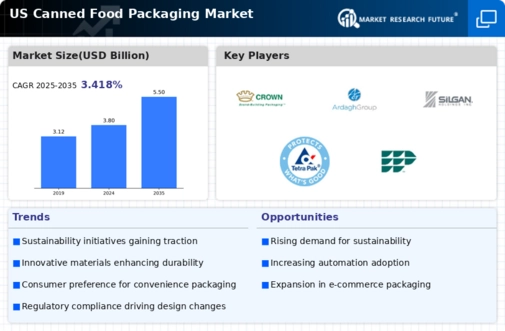Rising Demand for Shelf-Stable Products
The canned food-packaging market experiences a notable increase in demand for shelf-stable products. This trend is driven by consumers seeking long-lasting food options that require minimal refrigeration. In the US, the market for canned goods has shown a growth rate of approximately 4.5% annually, reflecting a shift in consumer preferences towards convenience and longevity. The ability of canned foods to maintain nutritional value over extended periods enhances their appeal, particularly among busy households. Additionally, the extended shelf life of canned products reduces food waste, aligning with consumer desires for sustainability. As a result, manufacturers in the canned food-packaging market are innovating to enhance the quality and variety of their offerings, ensuring they meet the evolving needs of consumers who prioritize both convenience and sustainability.
Technological Advancements in Packaging
Technological advancements play a crucial role in shaping the canned food-packaging market. Innovations in packaging materials and processes enhance product preservation and safety. For instance, the introduction of BPA-free cans and vacuum-sealing techniques has improved the quality and safety of canned foods. In the US, the market is witnessing a shift towards smart packaging solutions that provide real-time information about product freshness and safety. These advancements not only extend shelf life but also cater to the growing consumer demand for transparency in food sourcing and safety. As technology continues to evolve, the canned food-packaging market is likely to see increased investment in research and development, leading to more efficient and sustainable packaging solutions that meet regulatory standards and consumer expectations.
Consumer Preference for Ready-to-Eat Meals
The canned food-packaging market is experiencing a shift in consumer preferences towards ready-to-eat meals. As lifestyles become busier, consumers increasingly seek convenient meal solutions that require minimal preparation. Canned foods, often perceived as quick and easy meal options, are gaining popularity among various demographics, including working professionals and families. In the US, the ready-to-eat segment of the canned food market is projected to grow by approximately 5% annually. This trend encourages manufacturers to diversify their product lines, offering a wider range of flavors and meal types in convenient packaging. The appeal of ready-to-eat meals aligns with the broader trend of convenience in food consumption, driving innovation in the canned food-packaging market to meet consumer demands.
Increased Focus on Food Safety Regulations
The canned food-packaging market is significantly influenced by the increasing focus on food safety regulations. In the US, regulatory bodies such as the FDA impose stringent guidelines to ensure the safety and quality of canned products. Compliance with these regulations is essential for manufacturers, as it directly impacts consumer trust and marketability. The emphasis on food safety has led to enhanced quality control measures and improved packaging technologies. As a result, companies are investing in better materials and processes to meet these standards, which may increase production costs but ultimately benefits the market by ensuring safer products. This heightened focus on food safety not only protects consumers but also fosters a competitive environment where quality and safety are paramount.
Sustainability Initiatives in Packaging Materials
Sustainability initiatives are increasingly shaping the canned food-packaging market. As consumers become more environmentally conscious, there is a growing demand for packaging solutions that minimize environmental impact. In the US, manufacturers are exploring eco-friendly materials, such as recycled aluminum and biodegradable coatings, to reduce their carbon footprint. This shift not only addresses consumer concerns but also aligns with corporate social responsibility goals. The canned food-packaging market is likely to see a rise in products that emphasize sustainable practices, potentially attracting a broader customer base. Furthermore, companies that adopt sustainable packaging solutions may benefit from enhanced brand loyalty and market differentiation, as consumers increasingly favor brands that demonstrate a commitment to environmental stewardship.
















Leave a Comment